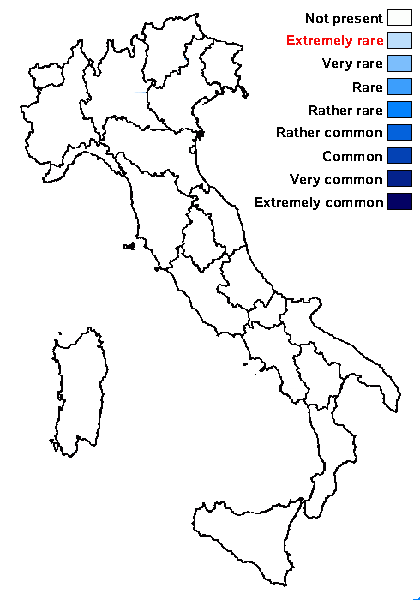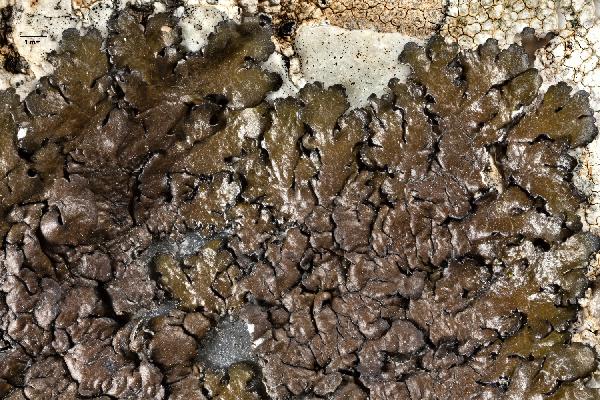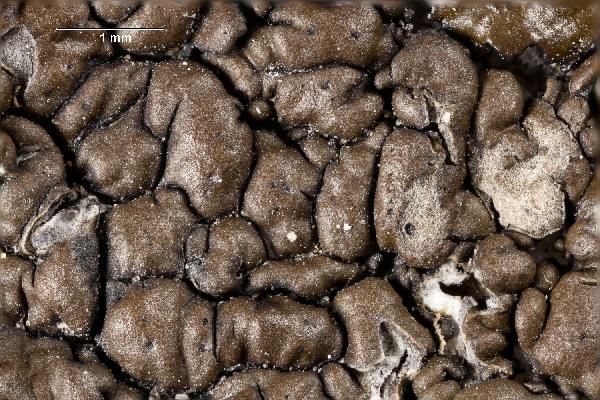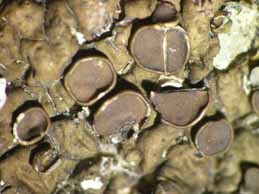Xanthoparmelia attica (Leuckert, Poelt & B. Schwarz) O. Blanco, A. Crespo, Elix, D. Hawksw. & Lumbsch
Taxon, 53, 4: 966, 2004.. Basionym: Parmelia prolixa var. attica Leuckert, Poelt & B. Schwarz - in Vězda, Lich. Sel. Exs. 43: 1069, 1972.
Synonyms: Neofuscelia attica (Leuckert, Poelt & B. Schwarz) Essl.; Parmelia attica (Leuckert, Poelt & B. Schwarz) Essl.
Distribution:
Description: Thallus foliose, heteromerous, dorsiventral, forming 5-12 cm wide rosettes. Lobes adpressed, 0.5-3 mm wide, flat, wrinkled and contorted in older parts, smooth or with a faint network of ridges, the upper surface dark brown, matt or glossy at tips. Lower surface black, sometimes brown at margins, with simple, black rhizines. Upper cortex paraplectenchymatous, brown, with a pored epicortex, the cell walls with Xanthoparmelia-type lichenan; medulla white; lower cortex paraplectenchymatous. Apothecia rather rare, lecanorine, sessile to subpedicellate, 1-1.5(-2.5) mm across, with a slightly concave to flat, dark brown disc and a thin, persistent, smooth thalline margin. Epithecium orange-brown; hymenium colourless; paraphyses c. 2.5 μm thick at mid-level, the apical cells up to 3.5 μm wide; hypothecium colourless. Asci 8-spored, clavate, the K/I+ blue tholus penetrated by a faintly amyloid apical cushion with parallel or diverging flanks, the wall K/I-, surrounded by a K/I+ blue outer layer, Lecanora-type. Ascospores 1-celled, hyaline, ellipsoid. Pycnidia laminal, black, globose, the wall mostly colourless, brown around the ostiole. Conidia straight, fusiform or bifusiform. Photobiont chlorococcoid. Spot tests: upper cortex K-, C+ blue-green, P-, UV-, N+ blue-green; medulla K+ yellow turning red-orange, C-, KC+ faintly orange in upper part, KC- or KC+ fleeting red, P+ yellow-orange, UV+ white. Chemistry: medulla with norstictic acid (major), alectoronic acid, and an unidentified fatty acid (minor). Note: a species growing on siliceous, sometimes weakly calciferous rocks in sunny sites, known from Greece, Cyprus and Turkey; to be looked for in Mediterranean Italy.
Growth form: Foliose, broad lobed
Substrata: rocks
Photobiont: green algae other than Trentepohlia
Reproductive strategy: mainly sexual
Commonnes-rarity: (info)
Alpine belt: absent
Subalpine belt: absent
Oromediterranean belt: absent
Montane belt: absent
Submediterranean belt: absent
Padanian area: absent
Humid submediterranean belt: absent
Humid mediterranean belt: absent
Dry mediterranean belt: absent

Predictive model

Ulrich Kirschbaum CC BY-SA 4.0 - Source: https://www.thm.de/lse/ulrich-kirschbaum/flechtenbilder
On weakly calcareous rock.
Warts with pycnidia
SE-Europe; N-Cyprus; SE of Girne; Beşparmak Mountains; between Girne Kayasi and Armenian Monastery (Sourp Margar) - Det. T. Lumbsch & T. Esslinger
Growth form: Foliose, broad lobed
Substrata: rocks
Photobiont: green algae other than Trentepohlia
Reproductive strategy: mainly sexual
Commonnes-rarity: (info)
Alpine belt: absent
Subalpine belt: absent
Oromediterranean belt: absent
Montane belt: absent
Submediterranean belt: absent
Padanian area: absent
Humid submediterranean belt: absent
Humid mediterranean belt: absent
Dry mediterranean belt: absent

Predictive model

 INDEX FUNGORUM
INDEX FUNGORUM
 GBIF
GBIF



